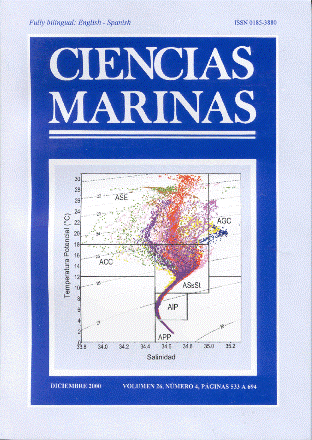Effect of flow speed and food concentration on the growth of juvenile scallops nodipecten subnodosus
Main Article Content
Abstract
An enclosed system with recirculating seawater was used to evaluate the effect of flow speed (0, 5, 10 and 15 cm/s) and direction (free organisms or horizontal with inhalant opening towards and against the flow or vertical towards the flow) on the growth of juvenile scallops Nodipecten subnodosus (5.5 to 7.7 mm). Growth rates were also measured at three different food concentrations (33, 66 and 100 cells/∞L) of Isochrysis galbana (clone T-ISO). The highest specific and absolute growth rates (SGR and AGR) were observed in free scallops and in scallops oriented horizontally towards the current (SGR = 2.5 %/d; AGR = 190 to 200 ∞m/d) at flow speeds between 5 and 10 cm/s. The next fastest growing organisms were those oriented vertically towards the flow and horizontally against it (SGR = 1.7 to 2.3 %/d; AGR = 129 to 169 ∞m/d). Free juveniles exposed to the highest speed (15 cm/s) were dragged by the current. Both scallop height and tissue dry weight increased in a hyperbolic relationship with increasing food concentrations. After 15 days, the highest values of shell height (7.5 mm) and tissue dry weight (3.5 mg) were observed with the two lowest food concentrations (33 and 66 cells/∞L). In conclusion, N.subnodosus juveniles can be successfully cultivated in the laboratory at flow speeds between 5 and 10cm/s and with a food concentration of 33 cells/∞L.
Downloads
Article Details
This is an open access article distributed under a Creative Commons Attribution 4.0 License, which allows you to share and adapt the work, as long as you give appropriate credit to the original author(s) and the source, provide a link to the Creative Commons license, and indicate if changes were made. Figures, tables and other elements in the article are included in the article’s CC BY 4.0 license, unless otherwise indicated. The journal title is protected by copyrights and not subject to this license. Full license deed can be viewed here.

